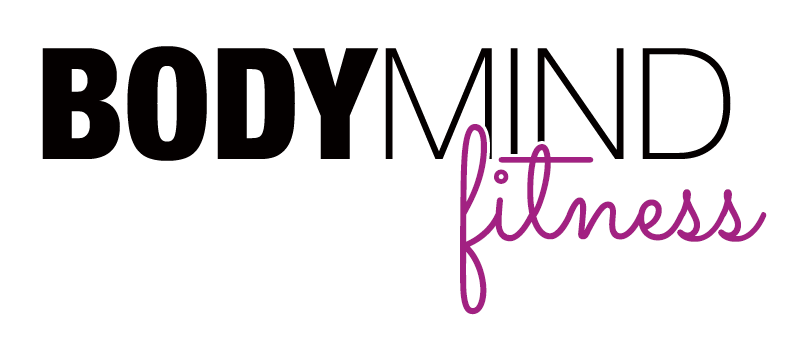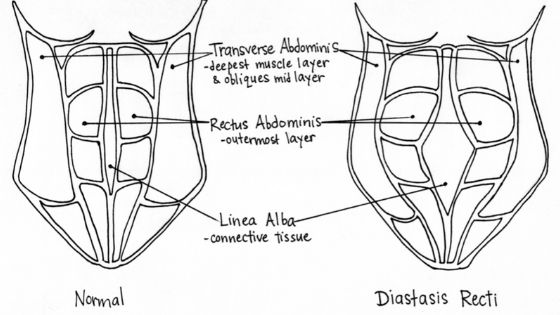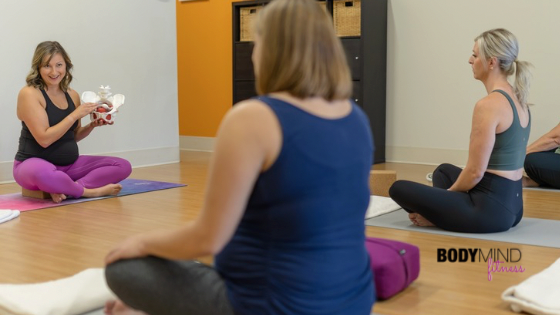I'm assuming that since you stumbled upon this article, you already know what is a Diastasis Recti (DR). But just in case a trip down a rabbit hole led you here, a Diastasis Recti is typically defined as a 2 cm gap between your 6 pack muscles (Rectus Abdominus). The gap is caused by a stretching of the soft tissue, called the linea alba which runs vertically between the two sides of rectus abdominis. Just to clarify, that this is not an outright splitting of the abdominals, and I KNOW I can't be the only one who thought this the first time I heard the words "abdominal separation".
Wait, it effects EVERYONE?!
Don't go anywhere if you're thinking, "I've never been pregnant, this doesn't apply to me", because DR can effect men, women, pregnant women, newly postpartum, moms who's kids are having kids, and yes, even those who've never carried babies, it's also super common in kids.
With that said, I wanna touch on pregnancy just for a moment, one of the most commonly asked questions I get in Prenatal Yoga class is, "How do I avoid abdominal separation?" Here's the truth, you can't. 100% of women will have a Diastasis Recti by 36 weeks pregnant. It's your body's natural way of making space for your growing baby - which is pretty incredible! Many women's DR will start take care of itself in those early days postpartum, and you may never know you even had one.
But, what do I do?
What you CAN do is minimize the severity of it by making sure
- you're hydrated
- stretching out your back muscles
- and avoiding putting too much pressure on the abdominals (that's why you're encouraged to roll onto your side to get up).
Pregnancy aside, DR can develop or get worse when we overload the abdominals without properly activating our deepest core muscles, the Transversus Abdominus (TvA). I find that this is SUPER common with new exercisers who are mimicking what they see, without yet knowing how to properly engage all the right muscles in each specific exercise. I was one of those exercisers - almost failing gym class in the ninth grade, and only really getting started with exercise in my mid 20s.
Simply, it's just too much too soon, and your body isn't quite ready for that yet.
Diastasis Recti doesn't just affect the abdominals - often being blamed for the "belly pooch", it can also cause back pain, constipation and leaking urine. While surgery might be the best route for some, there are specific strategies you can adjust in your everyday movements to help your Diastasis Recti heal.
YOUR CORE'S MAIN JOB IS TO STABILIZE AND PROTECT THE SPINE
I also have to mention, just like all pelvic floor concerns, back pain, or tightness are not a normal part of getting older, no matter how common it seems. I mean everyone complains about back pain, right? It isn't something you have to deal with, and taking care of your Diastasis Recti can help with that pain in your back. Or is it the other way around? Yup, this is one of those chicken or egg conversations.
While being able to fire the right muscles during exercise is super important, and working with some who specializes in pelvic floor exercises is a fantastic investment (Hi, I'm Dominique - pleasure to meet you), it's just as important to look at the ways you're moving in everyday life - and that's what brings us to my 4 tips to improve your Diastasis Recti.... which you're currently reading right now.
1) SHOW YOUR POSTURE A LITTLE LOVE
To be honest, there's no magical perfect posture for everybody. But there are ways to find YOUR perfect posture, and it doesn't mean you need to walk around 24/7 in this posture - but it's important to be able to access it when you need it most, like when your pelvic floor symptoms are bugging you (like that pesky power back pain).
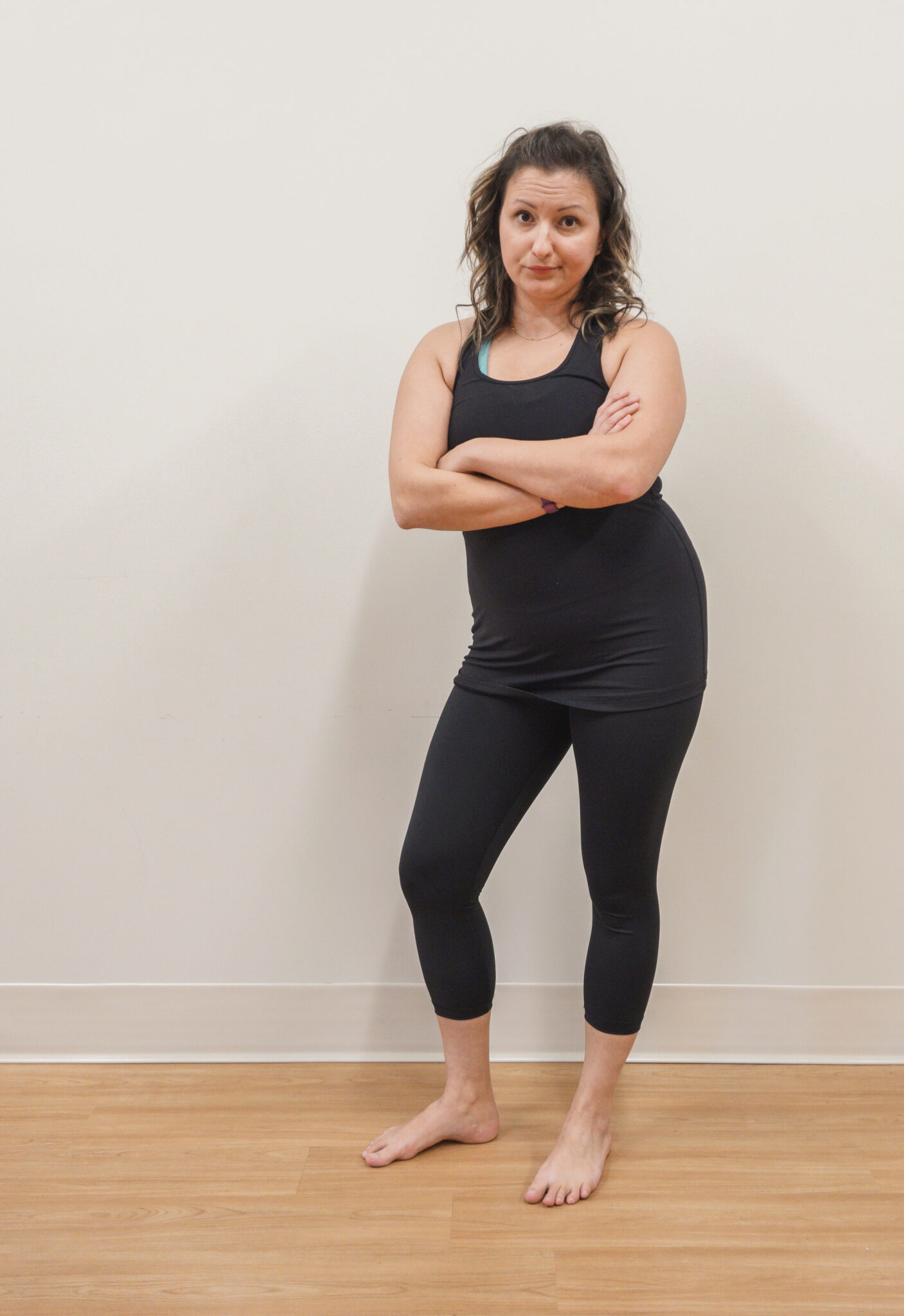
Your alignment should feel grounded but light, where your muscles are neutral - no contracting, no feelings of stretching, and definitely no compressing. So many of our modern day conveniences take a toll on our natural alignment, and we often end up hanging off of our joints especially when standing ➡
Please note: this posture may not necessarily cause or worsen Diastasis Recti, it's just an example of hanging off the joints.
In my experience, the most successful cue for aligning your body in standing is sliding your perineum between your ankle bones - it works on just about everyone... as long as you know where your perineum is. Its the area between your genitals and your rectum... you're picturing it now, right? This is best achieved when standing, the more you practice, the more you'll be able to access this feeling in a variety of positions - like sitting on long car rides. Start practicing every time it pops into your head.
Some additional helpful cues:
- feet underneath the hips
- soft knees
- ribs softening down
- draw the ears back in line with shoulders
Alignment can be crucial, when you round your back, this can put a lot of pressure on your abdominals, and we're only as strong as our weakest link. That pressure will try to get out, and will either push on your pelvic floor, or your Diastasis recti, which will continue to weaken this area.
2) 3-DIMENSIONAL BREATHING
So many of us are chest breathers and this is typically a stress response. This stress response can be reduced by mindfully using the diaphragm - the dome shaped muscle the rests just below the lungs. The diaphragm's meant to move downward and widen on the breath in, and draw up and in on the breath out. This doesn't mean actively squeezing and lifting, or bearing down - it's a gentle natural movement of these muscles when they're working together. The knowledge alone will take you a long way, but I wanna give you one more tip.
Chest breathing is all about breathing into the front of the body, it's now time to get the sides and back body moving when you breathe - this is what I mean about 3-Dimensional breathing. Imagine the bottom of your rib cage, like the bottom of this umbrella ➡
As you breathe in your ribs will expand outward in all directions, your ribs will return to their natural resting position when you breathe out. This is a tough habit to implement after years of chest breathing, but you've got this. When we don't breathe 3-Dimensionally, and fall into chest breathing- the muscles in the sides and back of the body get very tight, and essentially shut down (which happens naturally when we don't use a muscle) - but practicing this breath alone will start to loosen these muscles up and start to reawaken them. In no time at all, this will become easier, and then you have the bonus of using this breath as a tool to help destress after a hectic day.
3) CORE ACTIVATION
When I learned about lower abdominal contractions, my mind was blown. Try placing one hand just below your rib cage, and one hand between your hip bones - now go ahead and contract your abdominals. I'm willing to put money on the fact that you're feeling more sensation beneath your rib cage, and possibly no contraction in your lower abdominals. Nope, I'm not psychic, but after working with 100s of women - this is common and a big reason why your abdominal exercises aren't working.
I mentioned earlier about pressure in the body, and how we engage our core muscles can manage this pressure beautifully, by contracting from the bottom upward. So how do we do it?
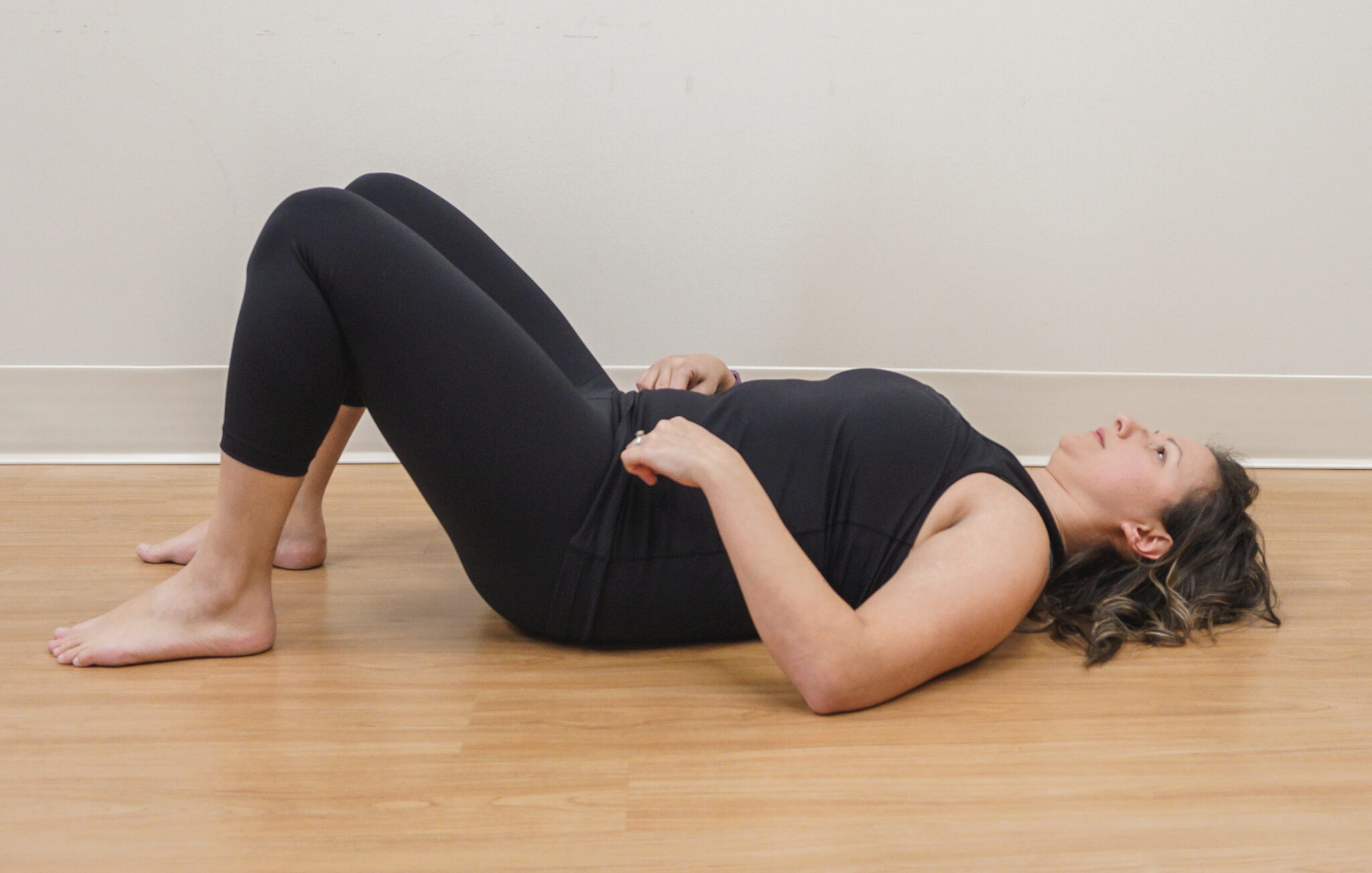 Lay on your back with your knees bent and feet on the floor. Identify where your hip bones are, take a 3-Dimensional breath in, exhale through pursed lips and think about squeezing the hip bones towards each other - no, they won't actually move, but this will encourage a lower abdominal contraction.
Lay on your back with your knees bent and feet on the floor. Identify where your hip bones are, take a 3-Dimensional breath in, exhale through pursed lips and think about squeezing the hip bones towards each other - no, they won't actually move, but this will encourage a lower abdominal contraction.
If you're having trouble with this, you can also try exhaling and stiffening the spine - not just the back, but using the entire core, front to back to stiffen the spine.
4) PUTTING IT ALL TOGETHER + MOVING THROUGH LIFE
This one is the key, once you've mastered the rest, and you will master them.
It drives me crazy when I hear "do your kegels when you're stopped at a red light," because sitting in your car at a red light is not where you pee yourself, or more on topic feel pressure in your belly. It's one thing to lay there and do these practices, it's a whole new ballgame once we add them into actual movements we do through out the day, like heavy lifting or even not so heavy lifting.
So let's put it all together.
Start bringing alignment, breath and core activation together, and then into movements like
- taking the garbage out
- unloading groceries from the car
- lifting your carseat with your baby (or stroller out of the trunk)
And if you're the exercise type, try adding these elements into a hands and knees position, tall kneeling, standing and then last but not least into ALL of your exercises. Feel how your core can become part of every single exercise, even ones that you don't consider core exercise like squats, lunges, and arm movements. This is what allows you to move in and out of the gym in ways that support the healing of your Diastasis Recti. This will keep your pelvic floor healthy for life.
Traditionally, it was about closing the gap, but times are changing, my friend, and now it's all about being able to generate tension in the linea alba so you feel strong and confident.
This doesn't have to be forever, just for now, while you heal.
Though these strategies can keep your pelvic floor healthy for life, it's not enough to just read this article, although the knowledge itself can start you off on the right path. It's time to put these tips into practice... start small with 1 tip at a time, and layer them until it feels a easier, then layer on the next, and then put them all together.
It's gonna feel weird at first, but with time, patience and practice you can do this. I'm cheering you on!

Special thanks to Pelvic Health Professionals and Lindsay Hobbs for the use of Diastasis Recti image used for the cover of this article.
